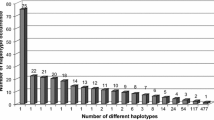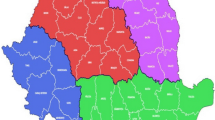Summary
In a given case with two or more siblings the bloodgroup findings may yield a high plausibility of paternity for the alleged father of the children whilst the HLA-A,B characteristics may exhibit an exclusion of fatherhood of one or other of the siblings. But this “exclusion” may disappear assuming an HLA-A,B recombination of a father's (or mother's) gamete. In such cases simple calculations (i.e., by hand) can provide the serostatistical characteristic L=Y/X (after Essen-Möller) for the given HLA-A,B constellation. In two-child cases with HLA-A,B findings for the putative father, the two pedigrees for the counterhypothesis Y are Yg1 and Yg2. The one holds for the case where the putative father is the father of child 1 and the other for the case where he is the father of child 2; in each case an unknown man is the father of the other child. The likelihood ratio is calculated as follows: L=Y/X=1/r·p(3,3)·p(3,4)·[p(4,4)+p(4,3)] / [p(3,3)·p(4,4)+p(3,4)·p(4,3)], where p(3,3) and p(4,4) are the frequencies of the putative father's HLA-A,B haplotypes in the pedigree YH1, p(3,4) and p(4,3) those in pedigree YH2, and where r is the recombination rate. In three-child cases and others in which the putative father is deceased and HLA results from legitimate children or siblings are available, and in which fatherhood is only possible if a recombinant haplotype interferes, only one counter-hypothesis exists. In these cases, the likelihood ratio is represented by L=Y/X=2/r·p(HR)·2I, where p(HR) means the frequency of the recombinant HLA-A,B haplotype, r the recombination rate and I(0, 1 or 2) the “difference in determined types.”
Zusammenfassung
Ist der angebliche Vater von 2 und mehr Kindern nicht durch übliche Blutgruppenbefunde, wohl aber im HLA-A,B-System als Erzeuger von einem der Geschwister auszuschließen, so kann dies an der Existenz eines auf den Loci A und B rekombinanten väterlichen HLA-A,B-Haplotyps bei einem der Kinder liegen. In solchen Fällen gelangt man, wie in der Arbeit gezeigt wird, auf einfache Weise, d. h. von Hand, zu einer für die gegebene HLA-A,B-Konstellation gültigen serostatistischen Kenngröße L=Y/X (i.S. Essen-Möllers). In Zweikindfällen mit HLA-A,B-Befunden des Putativvaters gibt es zwei Gegenhypothesen (HY1 und HY2) mit Stammbäumen YH1 und YH2. Die eine gilt für den Fall, daß der Putativvater der Erzeuger von Kind 1 ist, die andere für den Fall, daß er der Erzeuger von Kind 2 ist; jeweils ein Unbekannter ist dann der Vater des anderen Kindes. Der Likelihoodquotient errechnet sich wie folgt: L=Y/X=1/r·p(3,3)·p(3,4)·[p(4,4)+p(4,3)] / [p(3,3)·p(4,4)+p(3,4) p(4,3)]. Dabei sind p(3,3) und p(4,4) die Häufigkeiten der HLA-A,B-Haplotypen des Putativvaters in Stammbaum YH1, p(3,4) und p(4,3) die in Stammbaum YH2; r ist die Rekombinationsrate. In drei und mehr-Kind-Fällen sowie all jenen, bei denen der vermutete Erzeuger verstorben ist, statt seiner aber HLA-A,B-Befunde von 2 oder mehr ehelichen Geschwistern zur Verfügung stehen, gibt es nur eine Gegenhypothese YH. Für den Likelihoodquotienten dieser Fälle gilt L=Y/X=2/r·p(HR)·2I, wobei p(HR) die Häufigkeit des rekombinanten HLA-A,B-Haplotyps, r die Rekombinationsrate und I(0, 1 oder 2) die sog. “Definitionsdifferenz” ist und eine Erzeugerschaft nur möglich ist, wenn ein rekombinanter Haplotyp interferiert.
Similar content being viewed by others
Literatur
Baur MP, Neugebauer M, Albert ED (1984) Reference tables of two-locus haplotype frequencies for all MHC marker loci. In: Albert ED, Baur MP, Mayr WR (eds) Histocompatibility testing. Springer, Berlin Heidelberg New York Tokyo, pp 680–682
Belvedere MC, Curtoni ES, Dausset J, Lamm LU, Mayr W, van Rood JJ, Svejgaard S, Piazza A (1975) On the heterogeneity of Linkage estimations between LA und FOUR loci of the HL-A system. Tissue Antigens 5:99–102
Conradt J, Valentin J, Hummel K, Ihm P (1981) An algorithm to evaluate HLA results taking into account recombination between the A and B loci. In: Hummel K, Gerchow J (eds) Biomathematical evidence of paternity. Springer, Berlin Heidelberg New York, pp 151–158
Conradt J (1983) Serostatistische Abstammungsbegutachtung; ein Algorithmus für Verwandtenfälle und das Daten- und Programmsystem PAPS. Inaug Diss (Hum Biol), Marburg
Hummel K (1977) Abstammungsbegutachtung; Verständigungsschwierigkeiten zwischen Juristen und Gutachtern. Anhang: Beschreibung von 23 ungewöhnlichen Fällen strittiger Abstammung. In: Johannsen KH, Hummel K (Hsg) Vaterschaftsfeststellung bei nichtehelicher Abstammung. Molter, Heidelberg, S 63ff
Hummel K (1983a) Sonderfälle strittiger Abstammung aus den letzten 8 Jahren, deren Blutgruppen-und HLA-Befunde im Freiburger Blutgruppeninstitut biostatistisch per Computer ausgewertet wurden. 10. Internationaler Kongress der Gesellschaft für forensische Blutgruppenkunde. Referateband, S 295–310
Hummel K (1983b) Zur serostatistischen Beurteilung von „Großelternfällen“. 10. Internationaler Kongress der Gesellschaft für forensische Blutgruppenkunde. Referateband, S 237–348
Hummel K (1987) Zum „Utilitäts“-Prinzip im Rahmen der gerichtlichen Feststellung von Blutsverwandtschaft mittels Serostatistik, Z Rechtsmed 98:111–118
Hummel K, Ihm P, Schmidt V (1971) Biostatistical opinion of parentage based upon the results of blood group tests, vol 1. G. Fischer, Stuttgart
Ihm P, Hummel K (1975) Ein Verfahren zur Ermittlung der Vaterschaftswahrscheinlichkeit aus Blutgruppenbefunden unter beliebiger Einbeziehung von Verwandten. Z Immunitaetsforsch 149:405–416
Mayr W (1972) Grundlagen zur Berechnung der Vaterschaftswahrscheinlichkeit im HLA-System. Z Immunitaetsforsch 144:18–27
Ruthenberg A (1986) Überblick über die in den Jahren 1977 bis 1983 zur biostatistischen Auswertung per Computer ins Institut für Blutgruppenserologie in Freiburg eingesandten HLA-Befunde in Fällen strittiger Vaterschaft. Inaug Diss (Med), Freiburg im Breisgau
Author information
Authors and Affiliations
Rights and permissions
About this article
Cite this article
Fukshansky, N., Hummel, K. Biostatistische auswertung von HLA-A,B-befunden in fällen mit verdacht auf rekombination. Z Rechtsmed 100, 243–257 (1988). https://doi.org/10.1007/BF00201160
Received:
Published:
Issue Date:
DOI: https://doi.org/10.1007/BF00201160




